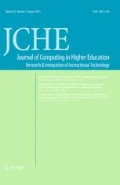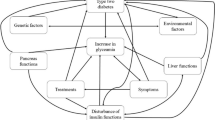Abstract
THIS ARTICLE discusses the metatheoretical aspects of a hypertext database about learning and instructional theory. The links among 45 theories, 18 concepts, and 17 learning domains are analyzed. The highest number of links were between theories and concepts or domains; there were relatively few links among theories themselves. The results of this analysis suggest that different theories of learning and instruction have less overlap than is commonly supposed. The value of this kind of tool for research and practice is discussed.
Similar content being viewed by others
References
Barrett, E. (1989).The Society of Text: Hypertext, Hypermedia and the Social Construction of Information. Cambridge, MA: MIT Press.
Berk, E. & Devlin, J. (1991).The Hypertext/Hypermedia Handbook. New York: McGraw-Hill.
Botafogo, R., Rivlin, E., & Shneiderman, B. (1991).Structural analysis of hypertexts: Identifying hierarchies and useful metrics.Department Computer Science, University of Maryland.
Dede, C. (1991).Designing a tool for imaging mental models underlying training. In L. Birnbaum (Ed.),Proceedings of the International Conference on the Learning Sciences. Charlottesville, VA: Association for the Advancement of Computing in Education.
Delany, P. & Landow, G. (1991).Hypermedia and Literary Studies. Cambridge, MA: MIT Press.
Duncan, E. (1989). Structuring knowledge bases for designers of learning materials.Hypertext, 1(1), 20–33.
Jonassen, D. & Mandl, H. (1990).Designing Hypermedia for Learning. Berlin: Springer-Verlag.
McAleese, R. & Green, C. (1990).Hypertext: State of the Art. Norwood, NJ: Ablex.
Shneiderman, B. & Kearsley, G. (1989).Hypertext Hands-On Reading, MA: Addison-Wesley.
Bibliography
Anderson, J. (1983).The Architecture of Cognition. Cambridge, MA: Harvard University Press.
Argyris, C. & Schon, D. (1974).Theory in Practice. San Francisco: Jossey-Bass.
Atkinson, R.C., Bower, G., & Crothers, E.J. (1965).An Introduction to Mathematical Learning Theory. New York: Wiley.
Ausubel, D. (1963).The Psychology of Meaningful Verbal Learning. New York: Grune & Stratton.
Bandura, A. (1986).Social Foundations of Thought and Action. Engelwood Cliffs, NJ: Prentice-Hall.
Bruner, J. (1973).Going Beyond the Information Given. New York: Norton & Co.
Card, S., Moran, T., & Newell, A. (1983).The Psychology of Human-Computer Interaction. Hillsdale, NJ: Erlbaum.
Carroll, J.M. (1990).The Nurnberg Funnel. Cambridge,MA: MIT Press.
Cermak, L., & Craik, F. (1979).Levels of Processing in Human Memory. Hillsdale, NJ: Erlbaum.
Cronbach, L., & Snow, R. (1977).Aptitudes and Instuctional Methods: A Handbook for Research on Interactions. New York: Irvington.
Cross, K.P. (1981).Adults as Learners. San Francisco: Jossey-Bass.
DeBono, E. (1967).New Think: The Use of Lateral Thinking in the Generation of New Ideas. New York: Basic Books.
Estes, W.K. (1970).Learning Theory and Mental Development. New York: Academic Press.
Festinger, L. (1957).A Theory of Cognitive Dissonance. Stanford, CA: Stanford University Press.
Gagne, R. (1985).The Conditions of Learning (4th ed.). New York: Holt, Rinehart & Winston.
Gardner, H. (1983).Frames of Mind. New York: Basic Books.
Gibson, J.J. (1979).The Ecological Approach to Visual Perception. Boston: Houghton Mifflin.
Guilford, J.P. (1967).The Nature of Human Intelligence. New York: McGraw-Hill
Guthrie, E.R. (1935).The Psychology of Learning. New York: Harper.
Hull, C. (1943).Principles of Behavior. New York: Appleton-Century-Crofts.
Knowles, M. (1984).The Adult Learner: A Neglected Species (3rd Ed.). Houston, TX: Gulf Publishing.
Landa, L. (1976).Instructional Regulation and Control: Cybernetics, Algorithmization, and Heuristics in Education. Englewood Cliffs, NJ: Educational Technology Publications.
Mager, R. (1988).Making Instruction Work. Belmont, CA: Lake Publishing Co.
Maltzman, I. (1960). On the training of originality.Psychological Review, 67(4), 229–242.
Merrill, M.D. (1983). Component Display Theory. In C. Reigeluth (Ed.),Instructional Design Theories and Models. Hillsdale, NJ: Erlbaum Associates, p. 90–146.
Miller, G.A., Galanter, E., & Pribram, K.H. (1960).Plans and the Structure of Behavior. New York: Holt, Rinehart & Winston.
Newell, A. (1990).Unified Theories of Cognition. Cambridge, MA: Harvard University Press.
Newell, A., & Simon, H. (1972).Human Problem Solving. Englewood Cliffs, NJ: Prentice-Hall.
Norman, D. (1982).Learning and Memory. San Francisco: Freeman.
Paivio, A. (1971).Imagery and Verbal Processes. New York: Holt, Rinehart & Winston.
Pask, G. (1975).Conversation, Cognition, and Learning. New York: Elsevier.
Reigeluth (Ed.),Instructional Design Theories and Models.Hillsdale, NJ: Erlbaum Associates.
Rogers, C.R. (1969).Freedom to Learn. Columbus, OH: Merrill.
Salomon, G. (1979).Interaction of Media, Cognition, and Learning. San Francisco: Jossey-Bass.
Scandura, J. (1977).Problem Solving: A Structural/Process Approach with Instructional Applications. NY: Academic Press.
Schank, R.C. & Abelson, R. (1977).Scripts, Plans, Goals, and Understanding. Hillsale, NJ: Erlbaum Associates.
Schoenfeld, A. (1985).Mathematical Problem Solving. New York: Academic Press.
Skinner, B.F. (1968).The Technology of Teaching. New York: Appleton-Century-Crofts.
Spiro, R.J. & Jehng, J. (1990). Cognitive flexibility and hypertext: Theory and technology for the non-linear and multidimensional traversal of complex subject matter. In D. Nix & R. Spiro (Eds.),Cognition, Education, and Multimedia (pp. 163–205). Hillsdale, NJ: Lawrence Erlbaum Associates.
Sternberg, R.J. (1985).Beyond IQ. New York: Cambridge University Press.
Sticht, T., Armstrong, W., Hickey, D., & Caylor, J. (1987).Cast-off Youth: Policy and Training Methods from the Military Experience. New York: Praeger.
Thorndike, E. (1932).The Fundamentals of Learning. New York: Teachers College Press.
Tolman, E.C. (1932).Purposive Behavior in Animals and Men. New York: Appleton-Century-Crofts.
VanLehn, K. (1990).Mind Bugs. Cambridge, MA: MIT Press.
Vygotsky, L.S. (1978).Mind in Society. Cambridge, MA: Harvard University Press.
Wertheimer, M. (1959).Productive Thinking (Enlarged Ed.). New York: Harper & Row.
Author information
Authors and Affiliations
Corresponding author
Additional information
Greg Kearsley is an adjunct professor in the department of Educational Leadership in the School of Education and Human Development at the George Washington University in Washington, D.C., where he teaches graduate courses and conducts research in the area of educational technology. Dr. Kearsley has written many books and articles on the subject of technology and education. He received his Ph.D. from the University of Alberta in 1978.
Rights and permissions
About this article
Cite this article
Kearsley, G. Hypertext as a tool for the metatheoretical analysis of learning theories: The TIP database. J. Comput. High. Educ. 4, 43–56 (1993). https://doi.org/10.1007/BF02941064
Issue Date:
DOI: https://doi.org/10.1007/BF02941064




